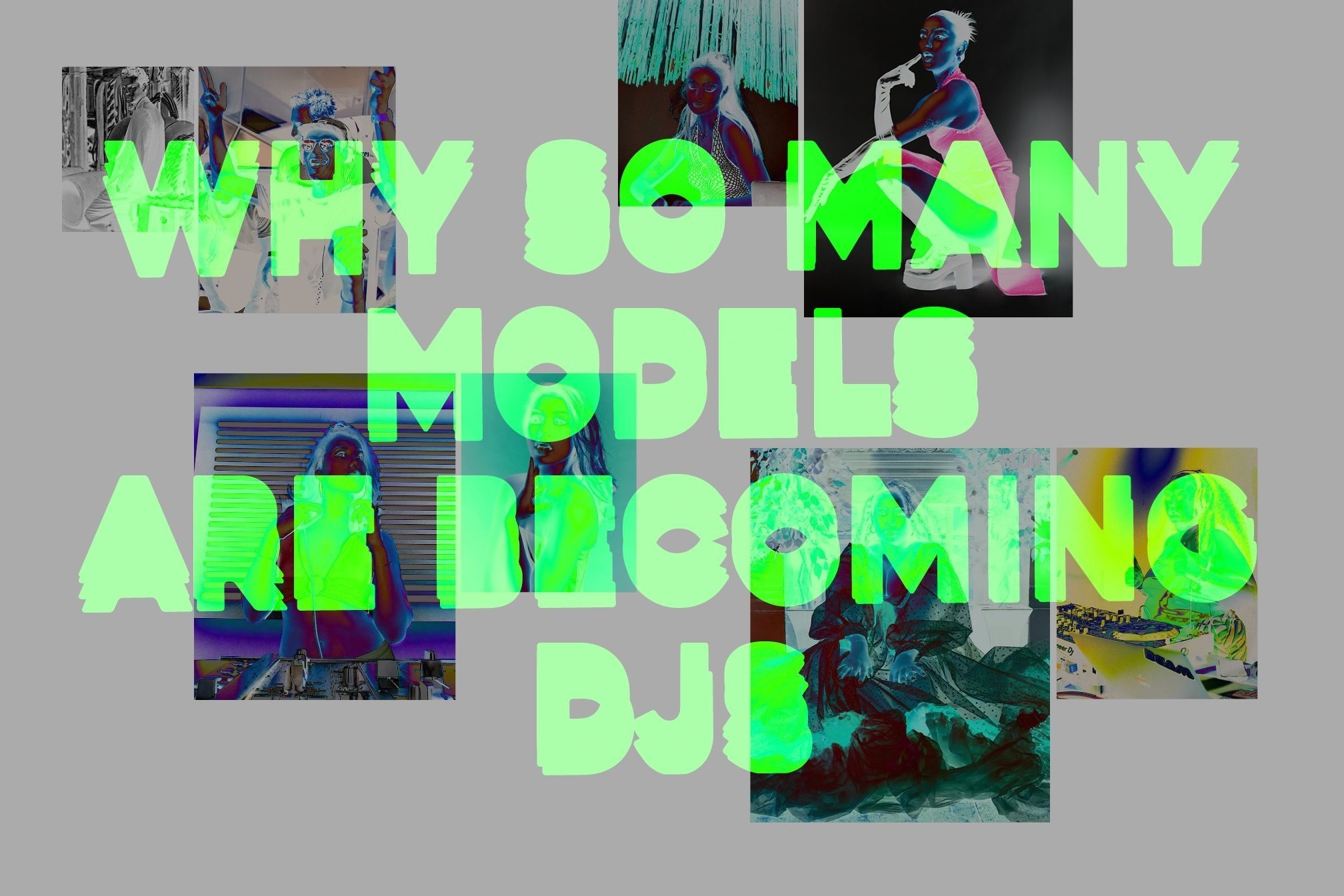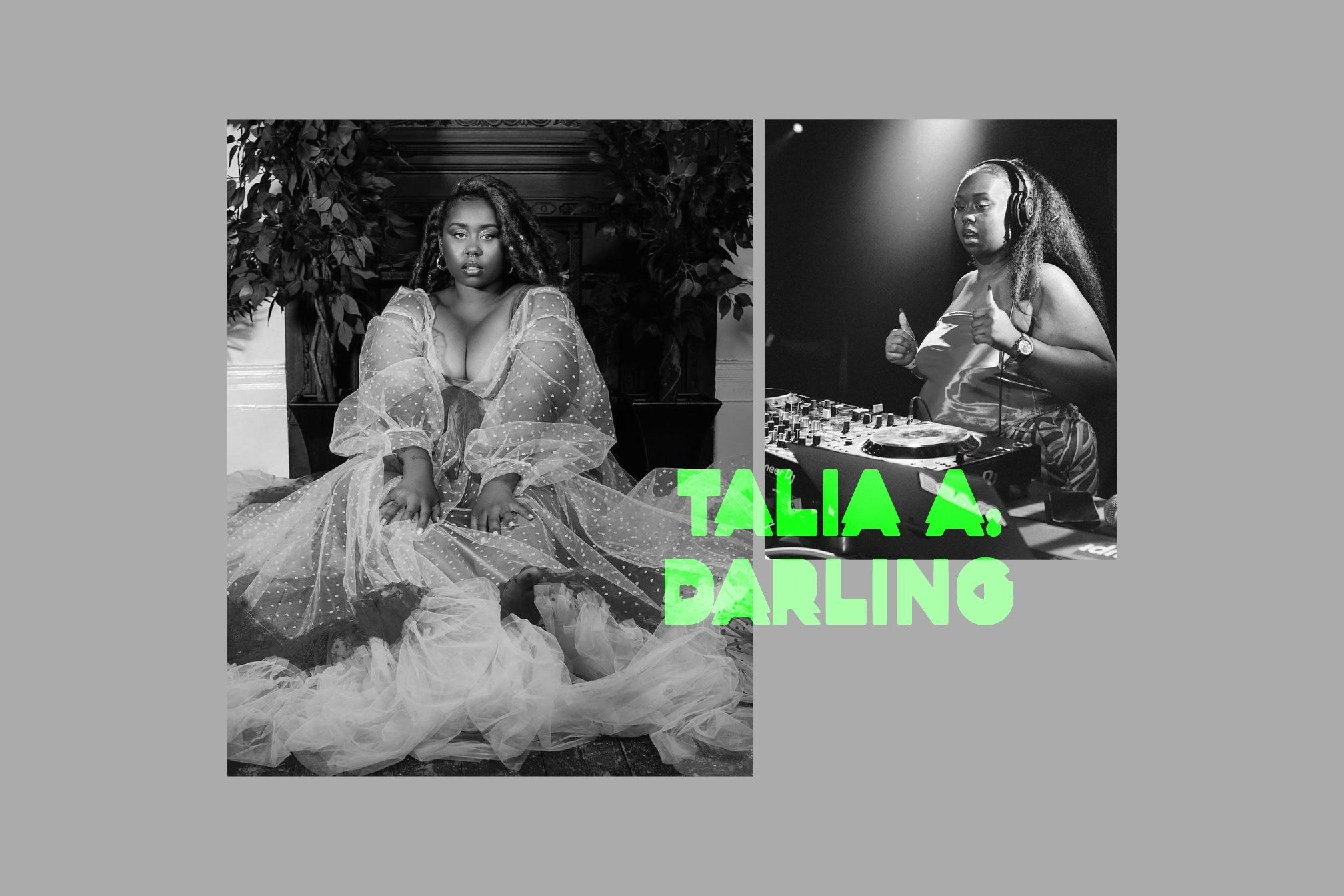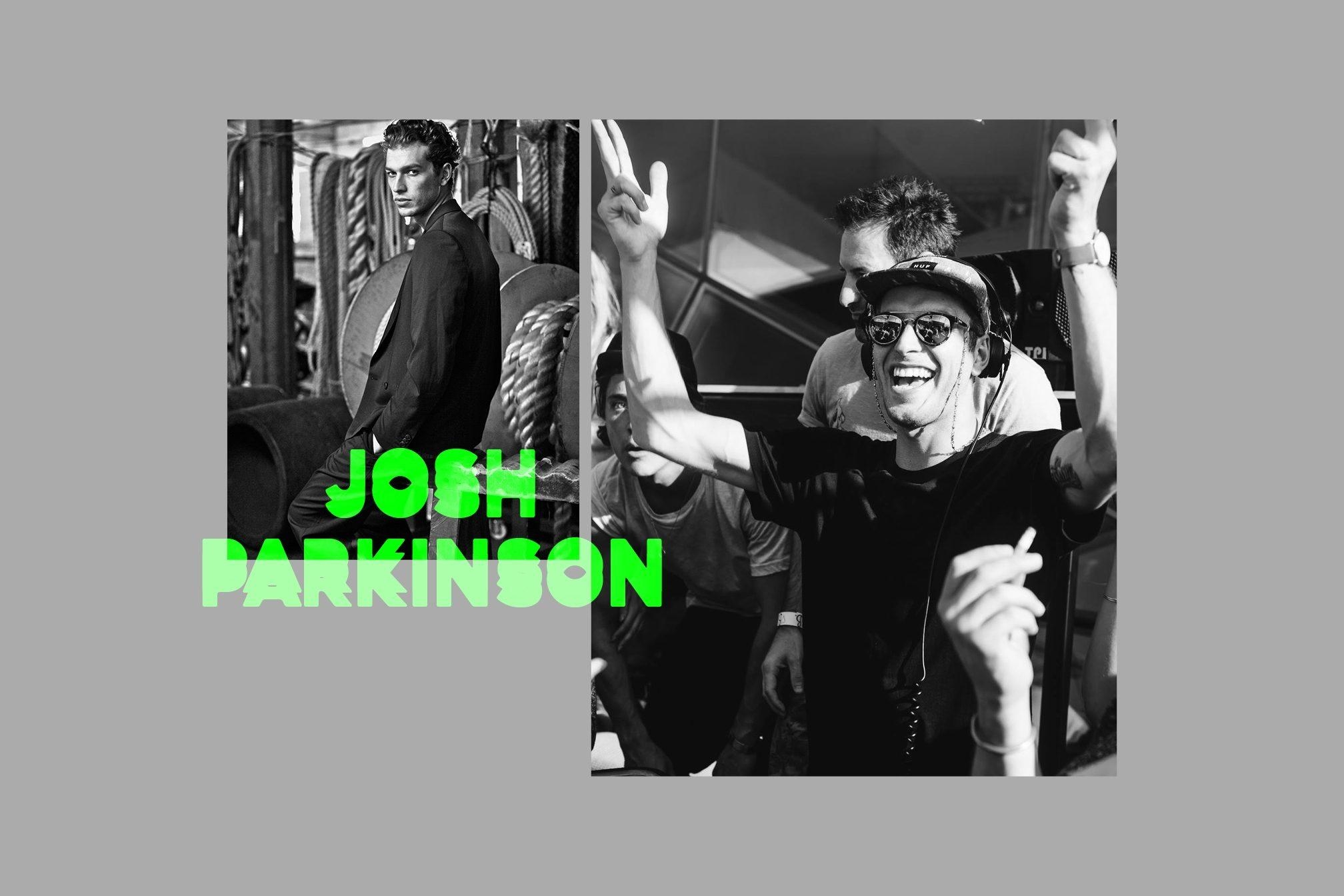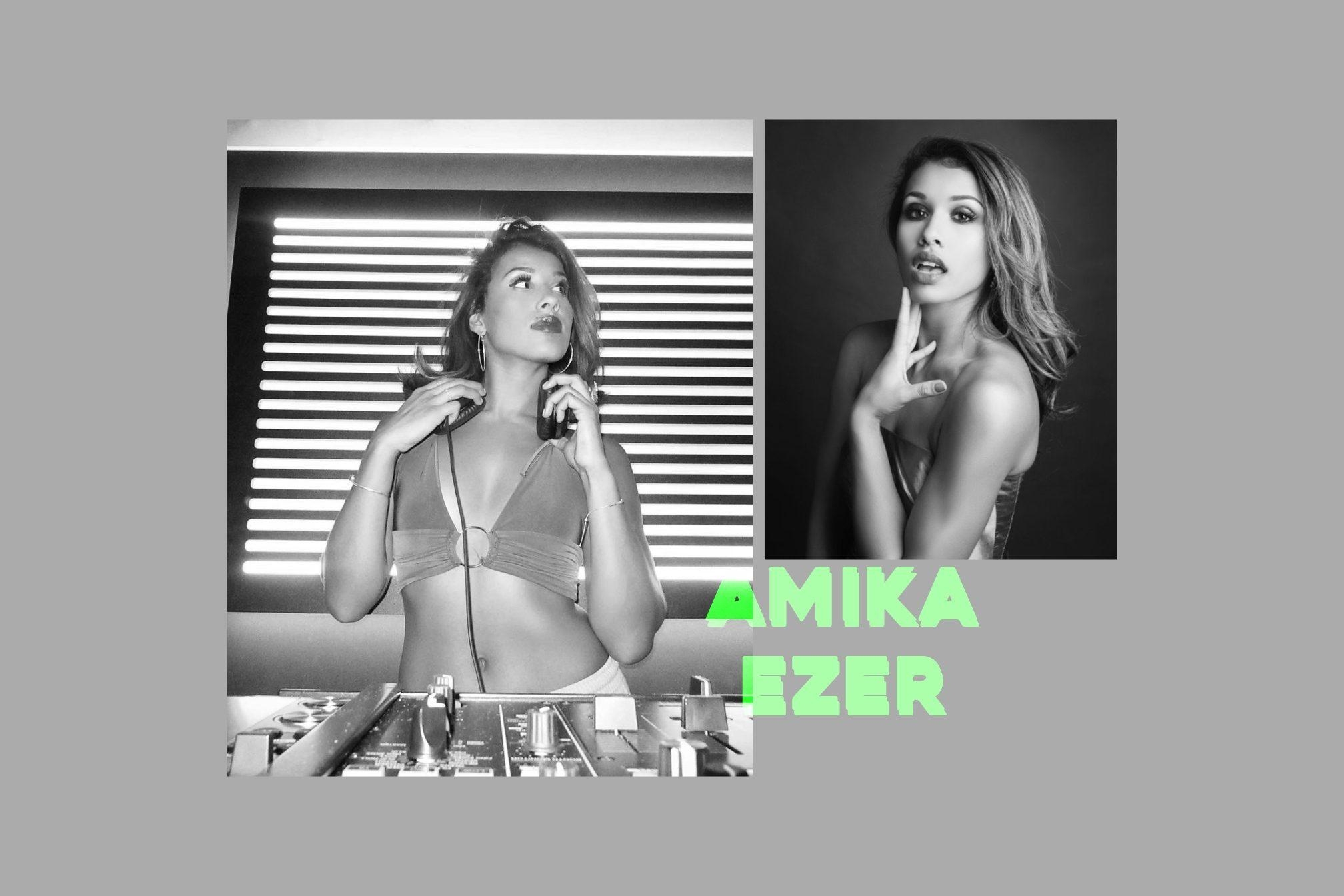 Interviews
Interviews
I love models: why so many fashion models are becoming DJs
Becky Buckle speaks with four model/DJs about the rise of the new style of double threat
10 years ago if you put the worlds ‘model’ and ‘DJ’ together, the first name that came to mind would probably be Paris Hilton, who debuted behind the decks in the summer of 2012 before landing $1 million a gig bookings and an Ibiza residency at Amnesia — much to the horror of dance music purists. But since then, the worlds of high fashion and DJing have become increasingly intertwined.
World leading fashion designers such as the late Virgil Abloh have moonlighted with music projects and maintained close links within the club scene, as the outpouring of grief and tales of his generosity from DJs across the board indicated last year, and Telfar Clemens revealed that the pricing of his popular Telfar Shopping Bag is based on a DJ’s wages.
On the other side, DJs such as Honey Dijon, Moodymann, and Black Coffee, who came up primarily through the club scene, have crossed over increasingly into the fashion world, collabing on clobber and collections with brands such as COMME des GARÇONS, New Era and Off-White™. Producer and DJ Mimi Xu has become best known for her catwalk soundtracks, and someone like Peggy Gou, who helms the Gudu Records music label and KIRIN streetwear brand, has become so prominent across both worlds that rather than be described as a DJ who designs or vice versa, she’s become the archetype of a multi-hyphenate who’s a notable figurehead in each world.
Read this next: The Secret DJ's run in with the world of high fashion
Nowadays every fashion function needs a DJ to keep the energy going and their youthful and edgy look intact. And as catwalks have become clubbier, models have become increasingly drawn to the world of dance music and DJing. Now the ‘I’m a DJ’ brag has been superseded by the ‘I’m a DJ and a model’ crew.
While it’s not new for people in creative industries to juggle multiple careers, lockdown has helped fuel that trend. It presented time to learn new skills, as well as exacerbating the uncertainty of careers in creative spheres which made diving into additional ventures an appealing bet.
But do model-DJs offer more than meets the eye? Are these faces too pretty for radio, and how committed are they to music? Is this a temporary trend or is it becoming an established step on a model’s career ladder? To find out more about how the combined lifestyles developed and co-exist, we spoke to four DJs/models with a range of experiences about their perception of their careers and how they balance the two.

TALIA A. DARLING
You may have seen Talia A. Darling on the covers of fashion mags, but fronting music mags could be on the horizon. She can be found helming sets on Foundation FM and performing at Leeds festival, Parklife, and popular club venues. With a business mindset and an attitude to succeed, Talia talks through her career journey.
How did you get into modelling and how did that eventually lead to DJing?
I’ve been a makeup artist for about seven years and so I got into modelling through that as I already knew people such as stylists. But being a model only came about a few months before I started DJing. I was in the industry, but I grew up being very insecure being plus size. After a trip to Jamaica, I got loads of confidence as it was a new world, I’d never been a part of before. Then I posted a picture of myself in a yellow suit on Instagram and it got loads of engagement. From there, I started doing shoots with my mates and putting them up on Instagram. In lockdown, I got scouted from my Instagram and was signed to an agency. That was when I finally felt like a model and not just an Instagram model. With being a DJ, I’ve always loved music so one day I said to my friend, ‘I want to become a DJ’ so we started our own DJ school. As I was working at a theatre at the time, I had access to a space and I jumped on board the six-week course which ended with a club night where I performed for everyone.
Would you say that social media is the best way to start your career as a DJ/Model?
It’s different for different people and what their intentions are. I use social media as people can screenshot it, look through my highlights and send them to clients. One of the reasons why I keep my Instagram looking the way it does is because they are looking at my looks because I don’t conform to society’s standard of beauty. I also understand that I am a novelty in terms of being a plus-sized female DJ and that will get me booked. It’s interesting how I know that my looks, or at least how I portray myself on Instagram, helps my DJ career. I’ve got lots of thing through my Instagram and that’s from DJing and modelling. Being in this virtual space is so much easier. I’ve got so much work and got to where I am in my career because of social media.
Read this next: How Instagram is changing the design of clubs and festivals
How does being a DJ and model work well for you?
I do a lot of what I call ‘paperwork’ which includes downloading music, queueing it up, making sets and mixes as well as just staying relevant. And with modelling I have to make sure my skin is good so juggling everything has been difficult. However, I think that the combo goes really sweetly together. Like having a model DJ at a fashion event makes so much sense to me. There would also be a photographer in that mix so these things just go really well together.
How do you feel DJs/models are viewed?
I was talking to my friends about this interview today and we were talking about this new wave of models becoming DJs. Not based on their skills but based on their looks and yeah, it’s annoying because I know I put in the time and effort. Pretty privilege gets you places and that’s for everything, including DJing. People especially want a pretty female DJ. I don’t know if it’s the same for male DJs, but I know that if you are being edgy and out there, you will be considered.

SIMONE
Former Britain’s Next Top Model contestant and previous club night organiser, Sim0ne is now a TikToking DJ. Playing mixes of camp icons such as Kylie, Lady Gaga and Charli XCX, while dressed head-to-toe in Fiorucci, is just a normal day in the life of Sim0ne. Not only has she been seen modelling for Karl Lagerfeld or spotted in The 1975’s music videos, but since the pandemic, Sim0ne has been thriving with her online content and has gone on to explore DJing. As a disco and house fanatic, she’s now enlightening her following about her love of music with mixes and social content.
Which came first, your DJing or modelling career?
I started modelling doing little shoots for clothing brands back in Edinburgh when I was a teenager and then got scouted at 21. When I was at university, I got straight into modelling. I always thought I was starting quite late for a model because the climate was a bit different with girls starting at 15, but now I look back and I realise that I was still really young to be travelling around the world and being in these situations.
I didn’t teach myself to DJ until the lockdown where I had the confidence to start learning, but I had always been within the scene. I used to run club nights during university back in Edinburgh and ended up helping start FLY festival. Anyway, I realised that I could just learn in my room because I was going to be here for the foreseeable future. I really wanted to make sure that people knew that I respected the music industry and had paid my dues by learning how to mix properly and beat match. I was like, ‘no one can clock me as just being a hot girl behind the decks.’ After I taught myself and once I was comfortable with it, I started to get booked for shows. It was also nice to have a moment where I had no modelling work coming in. We had no idea when lockdown would end so I may have even stopped working as a model; therefore I had to see what the next thing I’d want to do might be. I wish I had started earlier, but maybe lockdown was the perfect time to start looking into it. It did always seem like a boy’s club, especially the techno scene. I always felt like even though I was in that social environment, I didn’t really feel confident enough to get behind the decks.
Read this next: Mask on: The future of festival fashion & rave attire is here
Does the world of DJing and modelling work well together?
There has always been a connection between fashion and music. They are undefinably intertwined with one another. Many of the DJs I look up to are in both worlds, like Peggy Gou started in fashion obviously, Virgil Abloh and Dimitri From Paris used to mix for Chanel shows.
I recently played the Motel Rocks Christmas party which was really cool. It was nice to be able to play at those parties as I usually am attending them. So, to get to go and DJ was great. Because I’ve already got these relationships with brands, and I know a lot of the PR people from my modelling, they just slide into my DMs. Also, as it’s usually fashion events they get to dress you as well as you getting to be part of the event.
It's nice to see a lot more women getting into DJing because modelling is a female-dominated industry so to see them branch into other sectors is great. Like I was saying before, it did use to feel like a boy’s club but I’m not sure of that anymore as you have these mega DJs like Nina Kraviz and Peggy. I just think a lot more women are getting behind the decks. Modelling used to be Kate Moss and smoking cigarettes, when now it’s more Gigi Hadid and drinking green juices. You can’t really be going clubbing without planning.
How do you think social media has supported the rise of fashion and DJing combining?
I’ve seen so many people finally expressing themselves through social media and getting into DJing because it is a way of expression. So is modelling in a strange way. With DJing, you are doing it more for yourself, whereas with modelling it’s for someone else.
How does working in both career areas make you feel?
It’s very cool that I get to do everything I’ve ever wanted to – it’s very fulfilling. Every DJing show feels like a huge achievement, and I still love modelling. I’m so grateful for modelling as I’ve been able to do great things like working on the Juicy Couture campaign last year. But I’ve been doing it for 10 years now and I’ve done most sectors like runway and TV ads. DJing feels really fresh; I’m a bit more proud of what I do now and I feel a lot more successful.

JOSH PARKINSON
MC, DJ, model and producer, Josh Parkinson can do it all. His talents are enjoyed not only by the likes of Craig David and Pete Tong but also fashion brands such as Versace and Calvin Klein to name a few. Not only has he performed at some of the world’s best-known musical festivals, Josh’s modelling career and musical taste has seen him DJ for the fashion crowd. Nowadays you can catch Josh producing his own music and mixes filled with dance and disco beats. Josh also works as co-founder of the Save Our Scene movement which protests about the lack of support given to musicians from the UK government.
What came first for you, DJing or modelling?
I’d always loved music and got given my first mixer when I was 13. I was originally an MC and started to DJ at a pub when I was about 15. I got scouted to do modelling when I was like 18/19 and had no idea what modelling was about, but within a couple of weeks I was flown to New York for a shoot. When in New York I found out that I would be going straight to Milan to do Alexander McQueen, Calvin Klein and Fendi. All of a sudden, this job was flying me around and I was very absorbed in it. Then I met another model who was also into music and so we became a duo. We met doing shows and started playing dubstep as it was the peak of that scene at the time. As the crowds got bigger, I did more MCing and ended up as the hype man as well as doing back-to-back stuff. Sometimes I’d even extend my trips so that I could host a couple of things. Music was always the passion I had and modelling just happened.
How has modelling helped your career as a DJ?
Through modelling I guess was why I got a lot more fashion crowd gigs such as DJing at Versace and magazine parties. I met a lot of people along the way who would get me gigs which I wouldn’t have necessarily got from just being a DJ. I used to play a lot of high-end gigs for fashion crowds, but they weren’t really the ones I’d loved to play. So, it might have been for Versace, but it wasn’t the gig I’d want. I think they tend to use models for fashion events because they can dress you in their clothes. I would DJ in things like a boujee '90s power suit with big sleeves which would be a fun experience, but as I said, not the gigs that I’m in it for. But with DJs that aren’t models it could be an issue as if the guy is five foot and has bad taste in fashion, I think somewhere like Gucci would have a hard time trying to dress him in the brand-new catwalk looks. But the music for these parties can just be background music and is not always a proper party, party.
In the earlier days of modelling, you are partying a lot. You’ve got loads of free time and you get to go around the world with a group of lads. So, it can just be like a big party and if you’re into music it can pair nicely. I guess it is also easier because the contacts you make isn’t just from being out in clubs. When a friend and I were in a duo, our first proper gig was with Jack Wills. We’d both been modelling for Jack Wills and because we got along with them quite well, they booked us to DJ for one of their events in front of like 2000 people. After that, we got more gigs and they even ended up taking us to the Alps about five times for gigs they had over there. So, if you have a good relationship with a brand and they’re nice people it can work out perfectly. However, I do think that DJing hindered my modelling a bit because if I had the graveyard shift from 4-to-5:AM and a photo shoot the next day, you can imagine I wouldn’t be looking my freshest.
Read this next: From geopolitics to cyber punk: Damage is Taiwan’s pop culture provocateur brand from the future
How do you think social media has influenced this trend?
I think that it is because of Instagram. It’s like the whole ‘model-turned-actor’ thing that was a stereotype before. I feel like this is the new stereotype that’s happening. Whereas models turning into actors made sense as sometimes when you are modelling you have to act. Instagram is obviously flooded with rave videos, so I think it makes it out as quite an attractive career. However, I might spend a month making a track, post it on my Instagram for it to get minimal likes. Then I post a picture of myself topless on a beach and it gets loads of likes and flame emojis when all I am doing is standing there. I think Instagram rewards the wrong type of behaviours.
I don’t want to be mean to anyone but there is a lot of narcissism involved as people try to get their following up. They want everyone looking at them and to get the hype. A lot of models can get higher rates than building up the ranks within DJing. People think that because they’ve done Prada, all of a sudden, they can charge more than the DJ who has been doing it for 10 years and has a small Instagram following.

AMIKA EZER
From being the face of Rimmel London ads to the smile of Walkers Crisps, how did Amika Ezer end up DJing? Amika has worked in a rollercoaster of different sectors which have all led to a career in music. From presenting on kids channel CITV to being a hype girl on CBS, she now finds herself plugging at Polydor Records and is a familiar voice to be heard on Reprezent Radio and FIVE Radio Dubai.
How did you go from model to DJ?
It was always modelling for me from literally the age of 10. If I was ever asked what I’d want to do in the future I would say that, ‘by the age of 21 I’d be on the cover of Vogue, live in Brighton and have three cats.’ None of those things happened. As soon as I finished Uni, I did makeup modelling and lots of online clothing brands, but I actually wanted to become a presenter, so the bridge was from modelling to presenter to DJing. I’ve been in the music industry for the past six years and DJing for the past four.
Do you see similarities in the two careers?
Being a model is a form of expression, of putting your face out into the world and having to embody a look. I think DJing is the full package, especially for women as it's obviously a guy’s world. It is a way of putting yourself out there in completely different way. So going from modelling to DJing is just that extra edge.
Read this next: Peggy Gou appears on the cover of this month’s Harper's Bazaar Malaysia
How have you seen the world of fashion collides with the world of DJing?
I’d love to DJ at more fashion events as I mostly do brunches for influencers, which I mean are the new models nowadays. But with the rise of female DJs, they do have a certain incredible look about them. I guess people these days want to [showcase] people not just because they have a pretty face, which is why you are seeing models and DJs like Peggy Gou on magazine covers, as it’s nice to have a model that also has an incredible talent to them. Modelling is a performance and style which mirrors DJing. But looking a certain way as a DJ is also important; it’s obviously all about the music, but dressing well adds to it. I guess this is why models do turn into DJs, because you already have a look and coolness.
Would you encourage models to get stuck into DJing?
Obviously I’m biased, but it’s just such an incredible form of expression, it is the best feeling to DJ. To see all the smiling faces jumping around and liking your music, there is nothing better. I’ve explored a whole new realm with DJing and performing, and people not only liking your look but also your music. I would say that the look is a big part of being a DJ as well. It’s all about the music but you also want to look the full package. As fashion designer and DJ, Nigo once said that when asked ‘What’s fashion?’ he replied: ‘Music’.
Becky Buckle is Mixmag's Digital Intern, follow her on Twitter


